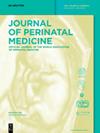Echocardiographic markers at diagnosis of persistent pulmonary hypertension of the newborn
IF 1.4
4区 医学
Q3 OBSTETRICS & GYNECOLOGY
引用次数: 0
Abstract
Objectives Clinical parameters along with echocardiographic markers are used to interrogate the haemodynamics in persistent pulmonary hypertension of the newborn (PPHN). The aim of this study was to compare different echocardiographic markers in recent cohort of newborn infants with and without PPHN. Methods In this retrospective study, common echocardiographic markers were examined in infants>34 weeks’ gestation with PPHN (cases) and without PPHN (controls). Infants with congenital heart disease were excluded. Binary regression testing was used to evaluate echocardiographic markers predicting PPHN and death. In addition, diagnostic accuracy testing of echocardiographic markers using ROC was also performed. Intra-observer reliability for echocardiographic markers was examined using coefficient of variation (CoV) and intraclass correlation. Results Fifty-two infants were studied; 22 (42 %) infants with PPHN had significantly higher oxygen requirement, oxygenation index and ventilation days when compared with controls. Echocardiographic markers such as TR Vmax, S/D TR, PAAT, TAPSE and eccentricity index (EI) were significantly different between cases and controls. Receiver operator characteristics analysis of echocardiographic markers revealed TR Vmax 0.96 (0.9–1.0), S/D TR 0.95 (0.87–1.0) and end systolic EI 0.94 (0.87–1.0). These markers were found to predict death in this cohort of infants. CoV and Intra-observer reliability was good for various echocardiographic markers. Conclusions Among the various echocardiographic markers studied, TR Vmax when present along with S/D TR and end systolic EI had good intra-observer reliability and were diagnostic of PPHN and predicted death in this cohort. Future trials could use these markers in studies examining PPHN.诊断新生儿持续性肺动脉高压时的超声心动图指标
目的 临床参数和超声心动图标记用于检查新生儿持续性肺动脉高压(PPHN)的血流动力学。本研究的目的是比较近期一组患有和未患有 PPHN 的新生儿的不同超声心动图指标。方法 在这项回顾性研究中,对妊娠 34 周的 PPHN 患儿(病例)和非 PPHN 患儿(对照组)的常见超声心动图指标进行了检查。患有先天性心脏病的婴儿被排除在外。二元回归测试用于评估预测 PPHN 和死亡的超声心动图标记物。此外,还使用 ROC 对超声心动图标记物的诊断准确性进行了测试。使用变异系数(CoV)和类内相关性检验超声心动图标记物在观察者内部的可靠性。结果 对52名婴儿进行了研究;与对照组相比,22名(42%)患有PPHN的婴儿的氧需求量、氧合作用指数和通气天数明显增加。病例和对照组之间的超声心动图指标,如 TR Vmax、S/D TR、PAAT、TAPSE 和偏心指数(EI),均有显著差异。超声心动图标记物的受体运算特征分析显示,TR Vmax为0.96(0.9-1.0),S/D TR为0.95(0.87-1.0),收缩末期EI为0.94(0.87-1.0)。这些指标可预测该组婴儿的死亡。各种超声心动图指标的CoV和观察者内部可靠性良好。结论 在所研究的各种超声心动图标记中,TR Vmax 与 S/D TR 和收缩末期 EI 同时存在时,观察者内部的可靠性较好,可诊断 PPHN 并预测该组婴儿的死亡。未来的试验可在研究 PPHN 时使用这些标记物。
本文章由计算机程序翻译,如有差异,请以英文原文为准。
求助全文
约1分钟内获得全文
求助全文
来源期刊

Journal of Perinatal Medicine
医学-妇产科学
CiteScore
4.40
自引率
8.30%
发文量
183
审稿时长
4-8 weeks
期刊介绍:
The Journal of Perinatal Medicine (JPM) is a truly international forum covering the entire field of perinatal medicine. It is an essential news source for all those obstetricians, neonatologists, perinatologists and allied health professionals who wish to keep abreast of progress in perinatal and related research. Ahead-of-print publishing ensures fastest possible knowledge transfer. The Journal provides statements on themes of topical interest as well as information and different views on controversial topics. It also informs about the academic, organisational and political aims and objectives of the World Association of Perinatal Medicine.
 求助内容:
求助内容: 应助结果提醒方式:
应助结果提醒方式:


